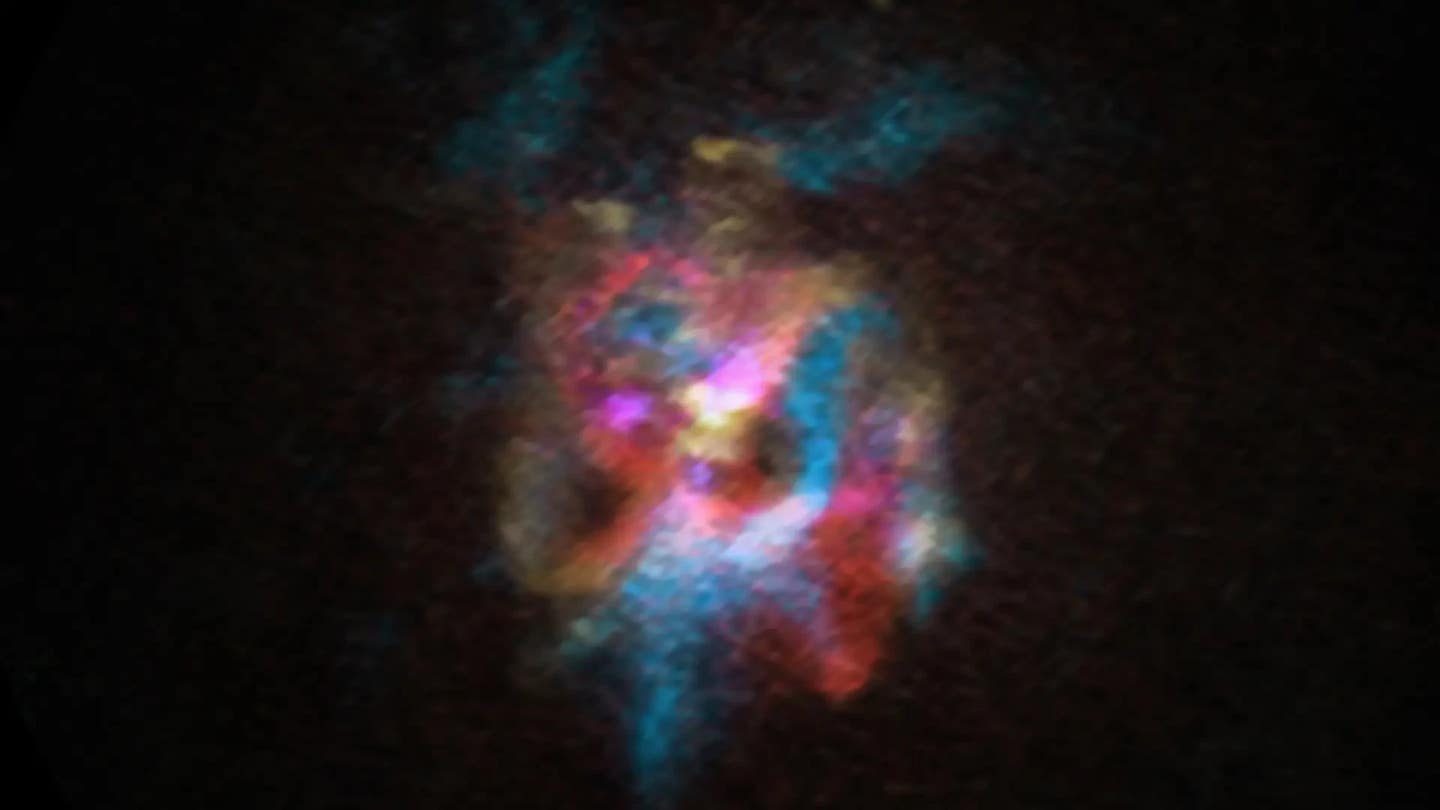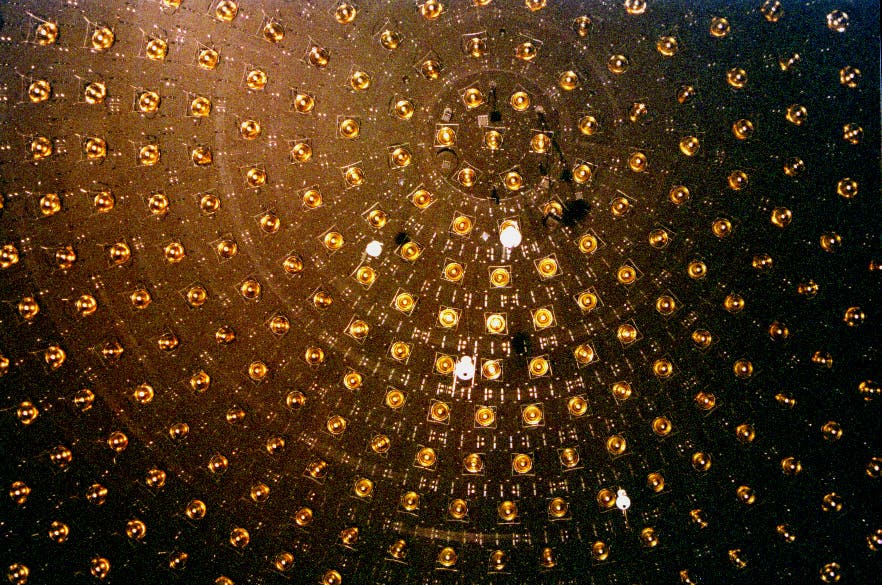Astronomers discover massive bubble around dying star
The bubble is so immense it stretches 1.4 light-years across, thousands of times wider than our solar system, and holds about as much mass as our Sun.

Red supergiant DFK 52 and its surroundings as seen by ALMA. (CREDIT: ALMA (ESO/NAOJ/NRAO)/M. Siebert et al)
High in the Milky Way, a dying giant has thrown astronomers a cosmic curveball. A star known as DFK 52, sitting in the massive Stephenson 2 cluster about 19,000 light-years away, has been caught surrounded by a vast, lopsided bubble of gas and dust. The bubble is so immense it stretches 1.4 light-years across, thousands of times wider than our solar system, and holds about as much mass as our Sun.
What makes this finding remarkable is not just the size of the structure, but the mystery of how it came to be. According to researchers from Chalmers University of Technology in Sweden, the bubble was expelled in a violent outburst roughly 4,000 years ago. That’s recent history in astronomical terms, yet the star itself somehow survived the massive upheaval.
A Twin of Betelgeuse With a Wild Side
DFK 52 is what’s called a red supergiant, a type of star nearing the end of its life cycle. These stars are colossal, with initial masses at least eight times greater than the Sun. As they age, they swell to enormous sizes, burn through their fuel, and eventually die in dramatic supernova explosions. Famous examples include Betelgeuse in Orion and Antares in Scorpius, both visible in a clear night sky.
When scientists turned the Atacama Large Millimeter/submillimeter Array (ALMA) in Chile toward DFK 52, they expected to find something similar to Betelgeuse. Instead, they were stunned. “We got a big surprise when we saw what ALMA was showing us,” said astronomer Mark Siebert of Chalmers. “The star is more or less a twin of Betelgeuse, but it’s surrounded by a vast, messy bubble of material.”
If this star were as close to Earth as Betelgeuse is, the bubble would appear about a third as wide as the full Moon in the sky—a sight no stargazer could miss.
Evidence of a Past Explosion
By measuring the movements of molecules within the bubble, the researchers confirmed it is expanding. This suggests the gas and dust were launched outward in an explosive event that ripped away part of the star’s outer layers.
Related Stories
- Astronomers find hidden channels of hot gas connecting our solar system to distant stars
- JWST detects giant exoplanet in the Alpha Centauri star system - just 4 light-years away
Elvire De Beck, another Chalmers astronomer, described it vividly: “The bubble is made of material that used to be part of the star. It must have been ejected in a dramatic event, an explosion, that happened about four thousand years ago. In cosmic terms, that’s just a moment ago.”
The findings also showed that the bubble is not a simple sphere. It is complex and irregular, with arcs and loops shaped by different speeds of escaping material. Astronomers modeled two main parts: a fast-moving, disk-like structure expanding at about 27 kilometers per second, and a slower, more spherical outflow moving at around 10 kilometers per second. Together, these features point to a star that once unleashed a sudden “superwind” phase, then calmed into a quieter rhythm of steady mass loss.
Why Didn’t the Star Collapse?
What remains puzzling is how DFK 52 shed so much matter and yet stayed intact. Red supergiants are known to lose material through strong stellar winds, but not usually on such a massive scale in such a short span of time. One possibility is that the star has a hidden partner. A companion star might have stirred up the outer layers, triggering a chaotic ejection of gas and dust.
“To us, it’s a mystery as to how the star managed to expel so much material in such a short timeframe,” Siebert explained. “Maybe, like Betelgeuse seems to, it has a companion star that’s still to be discovered.”
The oddity doesn’t end there. Unlike extreme red supergiants such as VY Canis Majoris or NML Cygni, which shine brightly and are famous for their huge outflows, DFK 52 is much dimmer. Yet it carries an even more enormous and clumpy envelope of material—something astronomers had never seen before.
A Glimpse Into Stellar Endings
For scientists, this star is a laboratory for studying how massive stars approach their deaths. When stars like DFK 52 finally explode as supernovae, the surrounding gas and dust can dramatically change the appearance and behavior of the blast. The shockwaves collide with this outer material, creating fireworks visible across galaxies.
The discovery has also sparked speculation: could DFK 52 be the Milky Way’s next supernova? “We’re planning more observations to understand what’s happening—and to find out whether this might be the Milky Way’s next supernova,” said De Beck. While the chances of the star exploding anytime soon are slim—likely within the next million years—it’s still a thrilling possibility.


The Power of ALMA
This breakthrough would not have been possible without ALMA, the international radio telescope array perched high in Chile’s Atacama Desert. By detecting faint signals from molecules in space, ALMA allows scientists to map structures hidden from optical telescopes. Sweden’s Onsala Space Observatory has been a key contributor to ALMA, even building receivers that make its sensitive measurements possible.
Thanks to this technology, researchers can now see in detail how stars shed their material, creating the very elements that make up new stars, planets, and even life. As De Beck noted, in studying these dying stars, “you’re also learning the life stories of all stars and planets.”
Practical Implications of the Research
The discovery of DFK 52’s giant bubble helps astronomers refine their understanding of how massive stars lose material and die. These insights are essential for predicting the timing and appearance of supernovae, which in turn affects how we study galaxies and the cosmic recycling of matter.
The gas and dust ejected by stars like DFK 52 seed the galaxy with heavy elements, fueling the birth of new stars and planetary systems. For humanity, this knowledge deepens the story of where the building blocks of life come from and sharpens our ability to detect and interpret stellar explosions when they occur in our galaxy.
Research findings are available online in the journal Astronomy and Astrophysics.
Note: The article above provided above by The Brighter Side of News.
Like these kind of feel good stories? Get The Brighter Side of News' newsletter.



